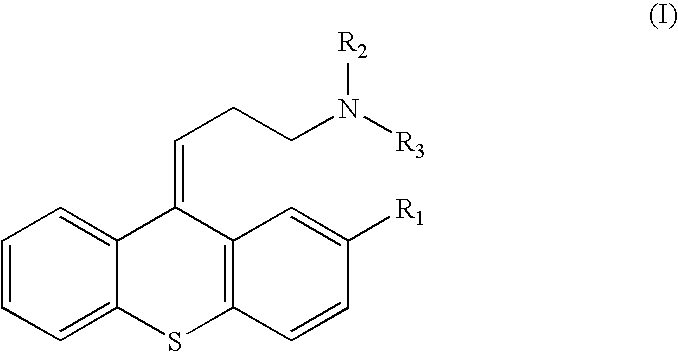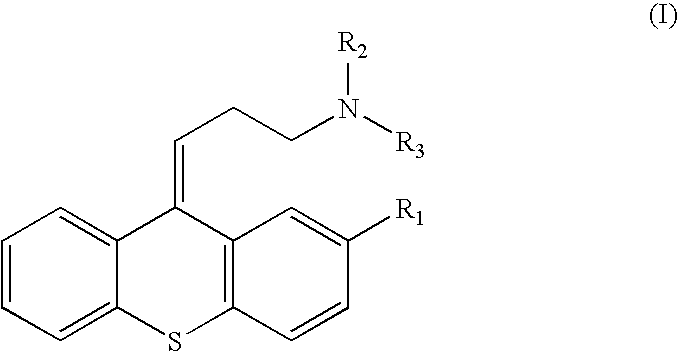Treatment of resistant Schizophrenia and other CNS disorders
a technology applied in the field of resistant schizophrenia and other cns disorders, can solve the problems of high no efficient treatment for 480,000 to 720.000 patients, and ineffectiveness of atypical antipsychotics, etc., to delay the occurrence of relapse, improve the safety profile, and reduce the risk of schizophrenic patients
- Summary
- Abstract
- Description
- Claims
- Application Information
AI Technical Summary
Benefits of technology
Problems solved by technology
Method used
Image
Examples
example 1
Therapy Resistant Schizophrenia
[0058]Case 1. A therapy resistant schizophrenic patient (37y) did not respond to the successive administration of four antipsychotic agents, each prescribed for a sufficient period of time and at a relevant dosage, and for whom compliance was controlled. After having been successively given oral haloperidol, oral risperidone, oral olanzapine, and oral clozapine, at appropriate doses and for sufficient duration, she was put exclusively on oral zuclopenthixol. Compliance to treatment was ascertained. Before being given zuclopenthixol, the patient presented severe debilitating schizophrenic symptoms. Soon after the start of zuclopenthixol treatment, the patient experienced a major relief of schizophrenic symptoms allowing her to return to normal life.
[0059]Case 2. Female subject (59 y) diagnosed with therapy resistant schizophrenia for the first time at the age of 40. The patient had been treated with oral amilsulpride, oral olanzapine, oral risperidone, ...
example 2
Therapy Refractory Schizophrenia
[0063]Female subject (27 y) diagnosed with therapy refractory schizophrenia for the first time at the age of 22 The patient had been treated with appropriate doses and for sufficient duration with oral aripiprazole, oral loxapine and oral olanzapine at appropriate doses and for sufficient duration. Compliance with treatment was ascertained. The patient exhibited significant relief of symptoms, but was nevertheless suffering from significant troublesome residual symptoms. The patient was then switched to oral zuclopenthixol. After 8 weeks of treatment with zuclopenthixol, the patient was evaluated as having “much improved”, as confirmed by C.G.I. and P.A.N.S.S., allowing the patient to achieve remission.
example 3
Naïve Schizophrenia
[0064]Upon diagnosis of schizophrenia, a naïve schizophrenic patient (19y) was given zuclopenthixol 50 mg p. o. per day as his first antipsychotic treatment, which proved to be successful. After a period of 5 years of treatment, the patient had still not relapsed.
PUM
| Property | Measurement | Unit |
|---|---|---|
| pharmaceutical composition | aaaaa | aaaaa |
| time prevalence | aaaaa | aaaaa |
| frequency | aaaaa | aaaaa |
Abstract
Description
Claims
Application Information
 Login to View More
Login to View More - R&D
- Intellectual Property
- Life Sciences
- Materials
- Tech Scout
- Unparalleled Data Quality
- Higher Quality Content
- 60% Fewer Hallucinations
Browse by: Latest US Patents, China's latest patents, Technical Efficacy Thesaurus, Application Domain, Technology Topic, Popular Technical Reports.
© 2025 PatSnap. All rights reserved.Legal|Privacy policy|Modern Slavery Act Transparency Statement|Sitemap|About US| Contact US: help@patsnap.com


